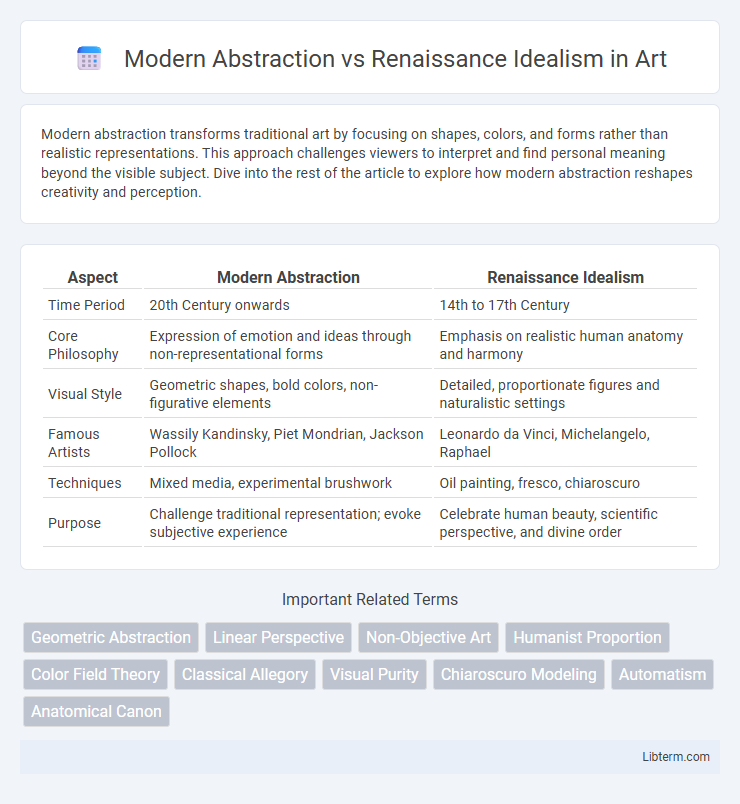Modern abstraction transforms traditional art by focusing on shapes, colors, and forms rather than realistic representations. This approach challenges viewers to interpret and find personal meaning beyond the visible subject. Dive into the rest of the article to explore how modern abstraction reshapes creativity and perception.
Table of Comparison
| Aspect | Modern Abstraction | Renaissance Idealism |
|---|---|---|
| Time Period | 20th Century onwards | 14th to 17th Century |
| Core Philosophy | Expression of emotion and ideas through non-representational forms | Emphasis on realistic human anatomy and harmony |
| Visual Style | Geometric shapes, bold colors, non-figurative elements | Detailed, proportionate figures and naturalistic settings |
| Famous Artists | Wassily Kandinsky, Piet Mondrian, Jackson Pollock | Leonardo da Vinci, Michelangelo, Raphael |
| Techniques | Mixed media, experimental brushwork | Oil painting, fresco, chiaroscuro |
| Purpose | Challenge traditional representation; evoke subjective experience | Celebrate human beauty, scientific perspective, and divine order |
Introduction to Modern Abstraction and Renaissance Idealism
Modern Abstraction emphasizes expressive forms, non-representational shapes, and emotional impact, breaking away from the detailed realism and harmony characteristic of Renaissance Idealism. Renaissance Idealism centers on balanced compositions, anatomical precision, and the pursuit of ideal beauty inspired by classical antiquity, reflecting humanist values and proportion. By contrasting these movements, the evolution of artistic philosophy reveals a shift from objective naturalism to subjective interpretation.
Historical Context: Emergence of Two Artistic Movements
Modern Abstraction emerged in the early 20th century as artists like Wassily Kandinsky and Piet Mondrian broke away from realistic representation to explore pure forms, colors, and emotions, responding to rapid industrialization and shifting cultural paradigms. Renaissance Idealism, rooted in the 15th and 16th centuries, reflected the revival of classical antiquity and emphasized balanced composition, anatomical precision, and idealized human proportions, driven by humanism and scientific inquiry during the European Renaissance. These movements illustrate a historical shift from the Renaissance focus on harmonious realism and idealized beauty to Modernism's embrace of subjective experience and abstract expression.
Core Philosophies: Abstraction vs Idealism
Modern abstraction emphasizes the reduction of forms to their essential elements, prioritizing subjective interpretation and emotional expression over realistic representation. Renaissance idealism centers on the pursuit of perfect, harmonious proportions inspired by classical antiquity, aiming to depict an idealized human form and divine beauty. These core philosophies reveal a shift from objective ideals to individual perception in art and meaning.
Techniques and Materials: Contrasts and Innovations
Modern abstraction employs unconventional materials such as industrial paint, mixed media, and digital tools to emphasize texture, form, and spontaneity, contrasting sharply with Renaissance idealism's use of traditional oil paints, precise brushwork, and fresco techniques aimed at realistic detail and harmony. Techniques in Renaissance art rely on linear perspective, chiaroscuro, and anatomical accuracy to create depth and idealized human figures, whereas modern abstraction breaks these conventions by experimenting with non-representational forms and embracing flatness and fragmentation. Innovations in modern art also include layering collage elements and incorporating technology, showcasing a shift from the Renaissance focus on mimetic representation toward conceptual and expressive exploration.
Influence of Culture and Society on Artistic Expression
Modern abstraction reflects the complexities of contemporary culture, emphasizing individual perception and emotional response, diverging from Renaissance idealism's focus on harmony, proportion, and classical beauty rooted in humanism and societal ideals of the time. The Renaissance period's artistic expression was deeply influenced by religious and philosophical beliefs that prioritized balance and realism, while modern abstraction challenges these conventions by embracing cultural diversity, technological innovations, and social upheavals. These contrasting approaches illustrate how societal values and historical contexts fundamentally shape the evolution of artistic styles and their meanings.
Prominent Artists: Then and Now
Renaissance idealism, epitomized by artists such as Leonardo da Vinci and Michelangelo, emphasized harmony, proportionality, and the perfection of the human form, reflecting the era's pursuit of beauty rooted in classical antiquity. Modern abstraction, championed by figures like Pablo Picasso and Jackson Pollock, breaks away from representational accuracy to explore subjective experience, emotional expression, and conceptual depth through fragmented forms and dynamic compositions. The contrast between these movements highlights an evolution from the Renaissance focus on anatomical precision and symbolic meaning to a contemporary embrace of innovation, experimentation, and individual interpretation in art.
Interpretative Freedom vs Prescribed Beauty
Modern abstraction empowers viewers with interpretative freedom by emphasizing subjective experience and emotional resonance, breaking away from traditional representational constraints. Renaissance idealism, rooted in prescribed beauty, adheres to harmonious proportions and anatomical precision to convey an objective aesthetic ideal. This contrast highlights a shift from universally accepted standards of beauty to a fluid, individual engagement with art.
Visual Language: Forms, Colors, and Composition
Modern abstraction employs geometric shapes, non-representational forms, and bold, often contrasting colors to evoke emotional responses and conceptual ideas, diverging from the Renaissance idealism's focus on realistic, proportionate human figures and naturalistic color palettes that emphasize harmony and balance. Composition in Modern abstraction is frequently asymmetrical and dynamic, breaking traditional spatial perspectives to challenge viewers' perceptions, whereas Renaissance art adheres to linear perspective and symmetrical arrangements to create depth and orderly narratives. The shift from Renaissance idealism to modern abstraction reflects a profound transformation in visual language, prioritizing subjective interpretation and symbolic expression over representational accuracy.
Lasting Impact on Contemporary Art
Modern abstraction revolutionized contemporary art by emphasizing subjective experience and emotional expression, influencing movements like Abstract Expressionism and Minimalism. Renaissance idealism, with its focus on proportion, harmony, and realism, established foundational principles that continue to inform classical training and figurative art today. Both approaches have left enduring legacies, shaping how artists explore form, representation, and meaning in the modern art landscape.
Conclusion: The Ongoing Dialogue Between Tradition and Innovation
Modern abstraction and Renaissance idealism represent pivotal artistic paradigms, with the former emphasizing subjective expression and the latter aspiring to objective perfection. This ongoing dialogue highlights the tension between tradition's structured beauty and innovation's exploratory freedom. The interplay fosters continuous evolution, enriching art by bridging historical legacy with contemporary creativity.
Modern Abstraction Infographic

 libterm.com
libterm.com